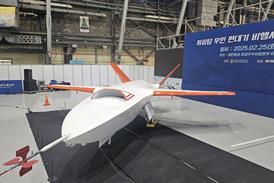Canada's Radarsat has been such a success that a second satellite is planned.
Tim Furniss/LONDON
IN JUNE, CANADA'S Spar Aerospace-built remote-manipulator-system robot arm was operated on yet another Space Shuttle mission, the STS77/Endeavour. Marc Garneau, one of Canada's four space travellers, was aboard for the second time. Garneau made his first flight in October 1984; now he is a NASA mission specialist.
High-profile sojourns such as these have overshadowed the launch of a Canadian satellite on 4 November, 1995. The Radarsat, which cost C$680 million ($500 million) to develop, is Canada's first Earth-observation spacecraft, with a synthetic-aperture-radar (SAR) antenna and instrumentation.
"In the fertile ground of the space industry, Canada has decided to sow a project that promises social and economic benefits," says Spar Aerospace, the Radarsat's builder and one of the shareholders in the Radarsat International consortium, which markets and distributes the images from the spacecraft's SAR instrument. The other shareholders are COMDEV and MacDonald Dettwiler of Canada, and Lockheed Martin, which distributes the data in the USA. Radarsat International is also the North American distributor of images from SAR instruments on Europe's remote-sensing satellites, ERS 1 and 2, and is Canada's distributor of Landsat and Spot images. The Radarsat is operated by the Canadian Space Agency (CSA).
The Canadian Government invested $500 million in the project and made private-sector funding a priority. Four provinces - British Columbia, Ontario, Quebec and Saskatchewan - provided $42 million funding and the private sector $46 million. The venture has been such a success that Radarsat International and other investors, including civil-engineering giant SNC Lavalin and Telesat, will fund the manufacture, launch and operation of the Radarsat 2, with the CSA taking a minor role. On 4 June, Spar won a $7.4 million contract to procure the first flight-hardware for the Radarsat 2.
DEVELOPMENT AND OPERATION
The Radarsat 1's development and operation, is expected to have created 10,000 person-years of employment, in Canada and over $590 million in benefits to public and business sectors, including urban planning, an example of, which is the city of Chicago's $110,000 deal with Radarsat to provide two pictures a week, to monitor boat and ship traffic on its busy waterfront.
Commercial users are expected to purchase about 150,000 images over the satellite's five-year life span, generating $295 million in revenue, $39 million of which will go back to the Government from Radarsat International in royalties. Sales so far amount to $8 million. This transfer of research and development into profitable activity is part of a Government policy that "-Government should take a leadership role in creating the climate and facilitating access to the tools which businesses need to grow".
Natural environmental monitoring has not been forgotten. Indeed, it was just this application which led to the creation of the Radarsat. The Northwest Passage and Beaufort Sea are strategic shipping routes, which must kept open all year. The Radarsat provides daily ice charts of the Arctic region and monitors coastal erosion.
The key to success is the 15m-long SAR antenna, which enables images to be made day and night whatever, the weather. Generally, for other types of optical satellite (about 20% of the time during daylight) normal images cannot be taken when there is cloud, smoke, dust, or fog.
Travelling at 7km/s, in a near-polar, 800km, circular orbit, the 3,200kg spacecraft circles the Earth 14 times day, crossing the equator at 06:00 and 18:00 local time, ensuring that the Sun's light can continually power the solar arrays. The orbit covers Canada every three days and the Arctic every day. The 500km swath of the craft provides equatorial coverage every four days and covers virtually the entire globe in four to five days.
Data can be collected for up to 400min a day. The Canadian Government gets 51%, or 200min, of the data. NASA - which provided the launch on a Delta - gets 15%, or 60min, a day. The remaining 133min, or 34% is up for sale. Real-time data is down linked to one of three processing centres in Alaska, Quebec and Saskatchewan. Other stations worldwide are licensed to receive and process data for commercial distribution.
Source: Flight International























